When you think of reptiles, the ocean is the not the first thing that comes to mind. Swamps, jungles, and deserts maybe, but not the ocean. This makes sense though being that reptiles are more terrestrial than they are aquatic. In fact, at one time in the planet’s history, they were the “Lords of the Land”.
One feature of having a backbone is that it can support more weight. Vertebrates can grow larger than invertebrates. There are advantages and disadvantages to this, but most see the advantages. Obviously one advantage is that you can overwhelm your prey. If you and a cockroach were both staring down a hamburger on a picnic table, you could easily squash the cockroach and game over. The cockroach could do the same back. A disadvantage could be in hiding. Elephants are not predators but where would an elephant hide if it were trying to sneak up on prey? Behind a tree? Really? But as we said, there may be more advantages to size than disadvantages.

Image: Encyclopedia Britannica
In the ocean water can support a large body. The giant squid can reach lengths of 50 feet and weigh tons. But it could not support itself on land. A large invertebrate on land might be one of the giant snails or crabs. Maybe a worm living IN the Earth and not ON it. But vertebrates can. Today the elephant can reach 11 feet in height and weigh over 13,000 pounds (6 tons). Better yet were the dinosaurs… according to the encyclopedia Britannica, Dreadnoughtus, a long tailed long necked herbivore, reached 85 feet long and 65 tons. Some of the dinosaurs were massive and thought to be connected to the reptiles. It is believed today that they were not reptiles but close relatives.
Either way, in order for vertebrates to walk on the land some changes had to happen to the fish design. It is believed that the vertebrates originated in the ocean with fish. There are a lot of different forms of vertebrate body design you could try for competition in the ocean, but you would be hard pressed to find a better design than the fish. There is a lot of variation in the fish design, almost 30,000, and we discussed this in Vertebrates Lesson 1, but this design will not work on land. The key characteristics of a fish are backbone, scales, gills, and fins. The backbone will be needed. Scales are fine – actually we will see they are needed as well. But gills and fins will not do. Lungs… lungs are what we need and legs. It is believed the lung originated from the fish swim bladder. There are fish today whose swim bladder is connected to the esophagus and serves a “lung” when droughts occur – we call them lungfish. The next step would be to enhance this design and get rid of gills.

The first animal to attempt this post fish design was a group known as amphibians. Amphibians are a class of vertebrates that have backbones, no scales, lungs and gills, and legs (at least most of them do). The interesting thing about this group of vertebrates is that they are the “in betweens”. Most amphibians breed and release their non-shelled (noncledoic) eggs in the water. This is much like a fish. The young are born looking more like fish (tadpoles) and living more like fish. The gills are still present and they breath more like fish. But eventually they go through metamorphosis, the tail retracts, limbs/legs form, and the lung becomes functional. At this point they can crawl up on land and be “land vertebrates”. However, their skin does NOT have scales and so they must protect themselves from the intense sun. Sunlight is much more intense out of the water and the body can dry out as well. So, most amphibians stay in, or near, the water. Most are active at night.
Better still, not all go through the process completely. Some amphibians never loose their gills. They may develop lungs, but the gills are still present. Most of these are salamanders and they remain in, or very near, the water. Some develop VERY TINY legs – or none at all – and again, stay near or in the water. Most lay gelatinous eggs in the water, some will form nests of thick mucus or give ovoviviparous birth – producing an egg but keeping it within the parent and giving “live birth”.
Amphibians are very interesting vertebrates and the first to exist on land. But they are closely tied to the water and could not exploit terrestrial habitats the way the reptiles could. We do not cover amphibians in marine vertebrate zoology because they did not inhabit the oceans or bays. The saltwater dries their scaleless bodies out too quickly.

Photo: Molly O’Connor
But the reptiles…
They fixed the problems of the amphibian design. Gills exist only during the early developmental stage within the shelled or cledoic egg. And the legs are well developed. They kept the scales that fish have and are better protected from the sun. With these changes they quickly became the “Lords of the Land” and gave rise to some of the largest land animals ever to have existed – the dinosaurs.
Today there are three orders within the class Reptilia, and there is at least one member who has returned to a live at sea. Let’s meet them.

Order Crocodilia
We all know the crocodiles and alligators. Today, they are the largest of the reptiles – some reaching over 20 feet and weighing a ton. They are closely associated with the tropics and do venture into the water. Some are known to venture into salt water. The saltwater crocodile of the south Pacific has been found swimming in the open ocean.
Alligators differ from crocodiles in the shape of their heads and position of their teeth. The head is more blunt and the lower jaw smaller than the upper jaw. When they close their mouths you only see the upper teeth.
In Florida we have both. The American crocodile inhabits the Caribbean region and some of the southern tip of Florida.
The American alligator can be found throughout the state, the southeast, and even into Oklahoma. It is the familiar mascot of the University of Florida and the star of many TV programs involving “gator hunters”.
Both are found in water and, at times, even in seawater. But they do not reside there. They are large carnivores feeding on a variety of prey they grab by ambushing. They only have canines in their mouth (homodonts) and thus cannot chew. Their prey must be either cut or swallowed whole. Most of their diet are small animals but if the opportunity presents itself, they will grab a large deer or hog. When they grab a large prey like this they will typically stash under water, maybe beneath a log, and allow it to soften so they can grab soft chucks and swallow whole. There are, of course, reports of alligators killing humans or their pets. Again, if the opportunity presents itself, they will. However, these animals have a natural fear of people and tend to stay away – unlike the Nile and Saltwater crocodiles of fame. But when people feed them, they learn this is an easier way to get food and lose that fear. When this happens problems will follow. Alligators then move into neighborhoods and, again, when an opportunity presents itself. For this reason, it is a felony to feed alligators in Florida.
Unlike most reptiles, alligators build their nests above ground. It is basically a pile of leaves, grass, and debris found on the land. The eggs are deposited within the nest. The leaves begin to breakdown in the subtropical heat and humidity which produces a damp warm environment for egg development and an acidic leachate that will help with egg hatching at the end. Unlike other reptiles, alligators will guard this nest from predators, and there are plenty. Near the end of development (about 65 days) the babies can be heard “squawking” within. They will do this when there is a need and the nearby parents – who have excellent hearing – will be there in a second. You should not hang around an alligator nest that has squawking babies. An interesting note here… the temperature within the nest will determine what sex the baby will be. Eggs incubated at 30°C or less become females. The warmer eggs, 34°C and up, become males.
At birth the babies are about six inches long and have bright yellow stripes. They hang with mom for a period of time to get a start in life. Mom is even known to carry her young in her mouth. They will stay with her for 1-2 years before striking out on their own. They are known to live 30-50 years. Both the American alligator and the American crocodile are federally protected animals. The American alligator’s populations, in some areas, are becoming much larger and de-listing is possible. There are certified/registered alligator hunts in most southern states.

Photo: Wikipedia.
Order Chelonia
Most people know the turtle. With their hard shells they are one of the most recognized and loved animals in our area. The shell of the turtle is a combination of layers including scales (called scutes), bone, tissue, and even nerves. It is part of the backbone system and has three parts. The carapace is the large domed portion covering the back. The plastron is the flat plate covering the bottom of the animal, and the bridge, is the sections on each side that connect the carapace to the plastron. The shell is very much connected to the turtle. Popular cartoons show turtles coming home from work and hanging their shells on a coat rack. They cannot remove, or leave, their shells – it is a part of them. Most can withdraw inside of it, which is cool for them. But not all! Sea turtles cannot. Box turtles take it a step further. Not only can they withdraw into their shells, the plastron is hinged and they can close it like the trunk of a car – very cool!
Having this heavy bulky shell means locomotion is slow. Turtles are famous for this but honestly, I have had to run to catch some. They are faster than you think – at least for a few seconds, they do tire easily. Locomotion is basically walking. Most are very aquatic and excellent swimmers. The sea turtles swim all of their lives, except when the females come ashore to lay eggs.
Turtles do not have teeth but rather a beak. In general, if the beak is serrated – they are herbivores. Smooth blades are usually carnivores. Those that are carnivores feed primarily on fish but some, like the snapping turtles, are known to eat small mammals, reptiles, birds, and even other turtles. Some, like the common pond turtles, feed on small insects and worms when there are young and on plants as adults. Many fear that these pond turtles will eat all of the fish in their ponds – but they are herbivores. However, a softshell or snapping turtle in the pond WILL eat your fish. Some, like the box turtles, are omnivorous – feeding on bugs, worms, plants, fruit, and some have been seen picking at roadkill!
Eggs of turtles are not laid in an above ground nest as with alligators. They dig a nest, and this must be done on dry land above the high tide mark, so they do not become wet. Some pond turtles will travel across roads and parking lots looking for a good nest site. Many will wander into your yard.
Once found, they will begin to dig a deep hole and deposit the shelled eggs. The number of eggs varies from one kind of turtle to another. Most terrestrial turtles (box turtles and gopher tortoises) lay very few… usually less than 10. Sea turtles are known to lay over 100. The nest is covered, and, unlike alligators, there is no parental care. The babies incubate for about the same time – 65 days and hatch underground. They will remain here until the “coast is clear” before emerging. It is believed in sea turtles they detect the temperature of the sand. Warm means daylight and you should wait. They may be sensitive to vibrations of people walking on the ground – so they ask folks to stay away from the nest by placing markers. When they do come, they rush for cover – it is “every man for himself!” They yolk sac is usually still attached, and they will feed on this for a short period time then turn to the food they love. Like alligators, sex of the offspring is determined by the temperature. But in this case, the warmer ones become females. Only in the softshells is this NOT the case. The sex of softshells is determined by genetics – not the temperature.
There are only a few marine turtles.
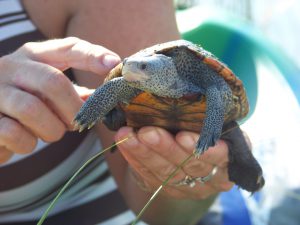
Photo: Molly O’Connor
The diamondback terrapin is a smaller turtles that inhabits salt marshes and mangrove swamps. It can tolerate brackish water but can only tolerate full strength sea water for only about a month. So, they are found in the estuaries.
The most common sea turtle in Florida is the Loggerhead Sea Turtle. This beast can have a carapace length of about 3 feet and weigh about 300 pounds! As the name implies, they have a large head as compared to their body size. They feed primarily on invertebrates and can be found in the bays and oceans.

Photo: UF IFAS
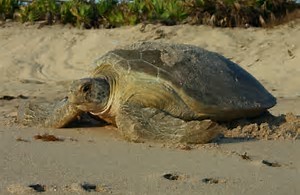
Photo: Florida Sea Grant
The second most common is the Green Sea Turtle. Green turtles are called so because of the fat within their bodies is a green color. This is due to their herbivorous diet. They feed on algae and seagrass; one species of grass being called “turtle grass” for this reason. The large fat deposits are common in sea turtles. This helps insulates them in the cold-water environments that they live in constantly – they do not “bask” on logs like the smaller pond turtles do – though some have been seen lying on the beach.
In the northern Gulf of Mexico, the third most common would be the Kemp’s Ridley Sea Turtle. This is a small sea turtle – about the size of a car tire – and more round than oval in shape. It is one of the most endangered sea turtles on the planet. This is due to a combination of their biology and human interaction. Kemp’s are known to nest on one stretch of beach in Mexico where they come up by the thousands… in the middle of the day! This makes them easy prey for humans – who collect them for their meat and eggs. Those who survive seem to travel across the northern Gulf to the Florida coast where they feed on a variety of fish and invertebrates. The route they follow takes them right through some of the biggest shrimping grounds in the Gulf as well as the offshore oil fields. Drowned Kemp’s are one of the most common sea turtles found in shrimp trawls and they were also one of the most common oiled turtles after the Deepwater Horizon accident in 2010 – though smaller spills occur each year.

Photo: Betsy Walker
To counter the shrimping issue, shrimpers are now required to use a Turtle Exclusion Device (T.E.D.S) in their shrimp nets. There is really no change for the oiled situation. Kemp’s numbers seem to be holding steady with efforts in Mexico to reduce harvest, re-locating Kemp’s nest to National Parks, and by-catch reduction in the shrimping industry. There numbers are still very low.
NOTE: It has been found that sea turtles return to the beach where they were hatched to lay their eggs. So, moving a Kemp’s nest to a national park would drive the next generation there and away from unprotected beaches where poaching still occurs.
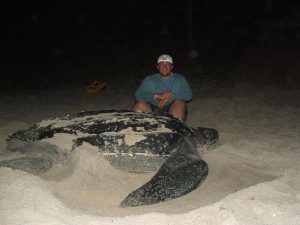
Photo: Dr. Andrew Coleman
The Leatherback Sea Turtle is a beast – the largest of them all. Their carapace can be six feet in length, and they can weigh 1000 pounds! They look like small boats when they surface to breath. These giants are found in the open sea and feed almost exclusively on jellyfish. All sea turtles will take a stab at jellyfish and whether they are stung, or immune to the sting, no one knows. But they do love them. HOWEVER, they cannot tell the difference between a jellyfish and a plastic bag or balloon floating near the surface. A balloon with a streamer in particular looks VERY much like a jellyfish. One Loggerhead sea turtle was found on Dauphin Island that had 11 pounds of plastic stuck in its throat. A dead Kemp’s Ridley found on Pensacola Beach was trying to expel plastic from its cloaca when it died. Plastic is a REAL problem not only for marine turtles, but a lot of marine life.
The giant leatherbacks rarely come into the estuaries. They prefer to sail the open seas feeding on jellyfish near the surface. Because of this they have had problems with both boat strikes and entanglement with fishing line and fishing gear. Both of these have played havoc on sea turtle populations. Being large, leatherback can travel into much colder water than other sea turtles. Like alligators, sea turtles are still subtropical ectotherms and can die from cold stress. IT IS AMAZING TO SEE ONE OF THESE LARGE LEATHERBACKS ON THE BEACH NESTING.

Photo: Molly O’Connor
The least common sea turtle in the northern Gulf (but pretty common in the tropics) is the Hawksbill Sea Turtle. As the name implies, this turtle has a “hawks bill” to tear and rip sponges from the reef for food – hence why they are not as common in the northern Gulf… the reefs and sponges are further south. This turtle has a beautiful colorful pattern to their plastron which has made them targets in the jewelry trade. “Tortoise shell” earrings, watches, and glasses go for very high prices – but cost the turtles their lives.
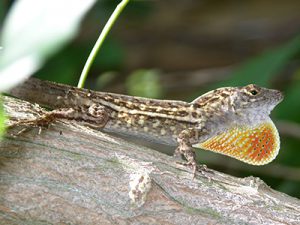
Photo: Dr. Steve Johnson
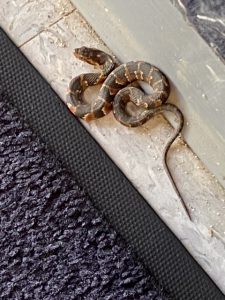
Photo: Molly O’Connor
Order Squamata
The last order of reptiles is the “new kids on the block” – the lizards and snakes. They have not been around on the planet as long as the alligators and turtles. Lizards and snakes are in the same order and VERY closely related. However, the difference between the two is not the presence of legs – there are “legless lizards” – it is the presence of an external ear and eyelids. Lizards have both – snakes have neither.
Thought they can swim well; these are more terrestrial animals than their cousins the alligators and turtles. There are over 40 species of lizards and 40 species of snakes living in Florida. Most of the lizards are non-native to the state with the greatest diversity found in the southern peninsula. The greatest diversity of snakes is in northern Florida, particularly the panhandle.
Though lizards and snakes are excellent swimmers, and many can swim in salt water, there are no true MARINE lizards and snakes here. That said, there are many who do swim to, and survive on, our barrier islands.
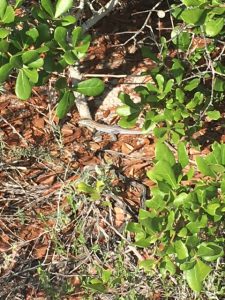
Photo: Rick O’Connor
The six-lined race runner is a common lizard found on our beaches as well as the green anole. On Pensacola Beach is one of the last populations of the horned lizard. Of course, as with other places in the state, our islands have plenty of non-native lizards. The green iguana is famous in the Florida Keys. The Argentine Black and White Tegu is a large (4 ft) lizard that is invasive and becoming more problematic. Nile monitor lizards, red agammas, and the Cuban anole are all invasive species that have entered the coastal areas of our state.
Like turtles, some lizards are herbivorous, like iguanas, and others are predators, like the tegu. All have sharp teeth and are homodonts – meaning they have the same type of tooth in their mouths and cannot chew their food – so, must be selective of their prey.
Most lizards lay shelled eggs in the sand or beneath logs or clay pots or something similar. Like turtles, there is no parental care for the young. Temperature determining sex is found in some lizards.
The only true marine lizard is the Marine Iguana of the Galapagos Islands.
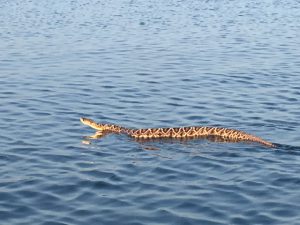
Photo: Sue Saffron

Photo: Molly O’Connor
There are numerous snakes that live on our barrier islands including at least two venomous ones – the eastern diamondback rattlesnake and the cottonmouth. Both are members of the family Viperidae and are known as “pit vipers”. The pits are small openings near the snout that can detect small changes in temperature indicating where their warm-blooded prey (rodents) may be lurking. The eastern diamondback likes dry sandy areas with good plant coverage to hide. They are daytime hunters and feed primarily on rodents and rabbits. The cottonmouth is closer to the water and – though they will feed on a variety of prey – prefer fish. Stomach analysis of cottonmouths has found small birds, rodents, lizards, amphibians, turtles, and even snakes – INCLUDING OTHER COTTONMOUTHS. They are opportunistic feeders and prefer to hunt at night.
The venom of these creatures is concerning to many but is a unique adaptation for animal with no arms or claws to grab and kill prey. The idea is to bite the victim when they are within range. They usually sit still – hiding – while the prey comes close – they do not “chase” their prey. Once bitten the venom not only kills the prey but actually begins the process of digestion while the snake is re-locating its lower jaws so that it can swallow it whole (again… homodonts). Nonvenomous snakes must grab their prey and figure out how to kill it while holding this thing. Some are constrictors but they do not actually “squeeze” their prey. Rather they coil around them with their mouth over the preys’ head. As the prey inhales, the snake tightens its coils. Eventually suffocation takes place, the snake knows this when the preys head goes cold, and now they can adjust their jaws to eat. Some studies suggest that death in the prey may not be from suffocation. The enzymes within the blood of the prey while trapped in the coils suggest that their heart rates are elevated, and that cardiac arrest may actually be the cause of death. Supporting this thought is how fast they prey dies, typically faster than suffocation.
Some species, like the Southern Black Racer, will just grab their prey and swallow it whole. Of course, they have to be particular of what that prey will be to do this.
So, for snakes, venom seems like a much easier way to do this. That said, there are actually few venomous snakes. In Florida we have 46 species, only 6 are venomous. All of this does not make people feel any more comfortable. One venomous snake is one too many. It helps you to understand that venomous snakes are definitely afraid of you. We have all heard this before “snakes re more afraid of you than you are of them”. Yea, yea, yea… I’m more afraid. BUT IT IS TRUE. They see us as a HUGE predatory – certainly not prey – and want NOTHING to do with us. Eastern diamondbacks show this in being very distant from humans. They usually inhabit territory FAR away from people and are rarely seen. Cottonmouths are a little human connecting, frequently found in yards and gardens with ponds. In either case, when the snakes do encounter people, they go through what I call the “3 F’s”. Freeze – Flight – Fight.
First, they will freeze, hoping not to be seen, and this works most of the time. Snake researchers have walked right past radio tagged rattlesnakes without seeing them – but know they are there by the radio signal they are getting. They argue that most people walk right by them without knowing. And the snake is fine with that.
If the snake feels they have been detected, most will FLY (FLIGHT) – run for it. Black racers and many others are famous for this. Unfortunately, the thick bodied vipers are not fast. They may crawl off but will do so very slowly. What they do, and others snakes as well, is warn you that they are there – giving up their hiding place – and letting you know you are too close. Many snakes will vibrate their tails to do this. Rattlesnakes have a modified tail to make this loud and clear. But cottonmouths, black racers, and even rat snakes will do this. Many will flatten their bodies to make themselves look larger and more intimidating – again, the idea is that YOU GO AWAY. And the cottonmouth will take it a step further… they will open their mouths exposing the bright white inner lining where they get their name “cottonmouth” as a further warning.
The venomous snakes DO NOT want to waste their precious venom on you. As my professor taught me, venom is “expensive”. It takes energy and resources to produce it and they do not want to waste it on you. It was meant for prey. But… they will if they feel they need to save their lives.
The third “F” is FIGHT. If they feel there is no escape, and their warnings have not moved you off – instead you come closer – explain to me WHY you are doing this??? – they will FIGHT… they will BITE. Often in the vipers you will get a dry bite. This is a bite where no venom was injected (saving for what it was really meant to do). But you can’t count on this. So, if bitten by a viper PLEASE seek medical treatment ASAP. Do not assume there was no venom.
You might ask the question (I do) why would anyone come closer to a venomous snake warning you to stay away? More often than not it can be answered two ways. 1) They are trying to kill it. 2) They are trying to catch it. 95% of all snake bites in the U.S. are due to one of these two. Lesson there… if it is rattling or gaping – leave it alone.
As you can imagine, snakes are carnivores – there are no herbivorous snakes. What they feed on varies but small prey – particularly rodents are top on their list. Some, including cottonmouths, have been known to feed on carcasses of cleaned fish or left-over shrimp in a bait bucket. Many feed on amphibians and live fish are attracted to outdoor ponds. Many will hang beneath bird feeders or nests waiting on the chance of a small chick, or left-over food from mom, to fall to the ground. Few take on large prey. Rabbits might be one that rattlesnakes target. The famous Burmese python – though more freshwater, they have been found in estuaries – will take a deer or alligator if the snake is big enough. The record in Florida at the moment is 18 ft. That’s big enough.
Like lizards, most snakes lay shelled eggs beneath logs or buried in the sand. A few, and the vipers are one group, keep the egg within the parent and give “live birth” – ovoviviparous. After the birth the mother will stay close until the babies have shed their skin for the first time – and then they are on their own. NOTE: many feel that young venomous snakes are less venomous than the adults. Though they may inject less venom, the venom is still as toxic as the adult and these should be treated with care. Another note: the young are many times more aggressive than the adults – survival instincts most probably. Most snakes live to be 10-20 years old.
Like the lizards, there are no true marine snakes in the Gulf of Mexico. Though many of our local residents will swim across salt water, or lie along the shore waiting for fish, the true sea snakes are only found in the south Pacific, west coast of Mexico, the Indian Ocean, and in the Red Sea.
Reptiles are scary and amazing creatures and capture the imagination of many people.
ACTIVITIES
- You can see and watch many reptiles at local zoological parks and aquariums. There is an alligator park in Baldwin County AL open to the public where you can see these creatures. A couple of other parks you can visit
- The Navarre Park Sea Turtle Conservation Center
- Gulfarium
- The Estuarium at Dauphin Island Sea Lab
- The Zoo in Gulf Breeze
- The Turtle Center in Flomaton AL
- Get a tape measure and sidewalk chalk. Find the length of the worlds largest reptiles and draw them on your driveway. You will be amazed how long they are.
- Explore the woods and ponds around your home where there is a wooden boardwalk that allows this. State and national parks, the University of West Florida, some local public parks along waterways. There is no guarantee you will see anything, but you might – and from the safety of the boardwalk 😊
 0
0
